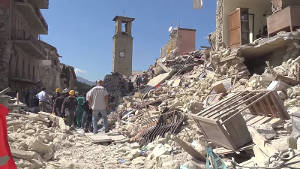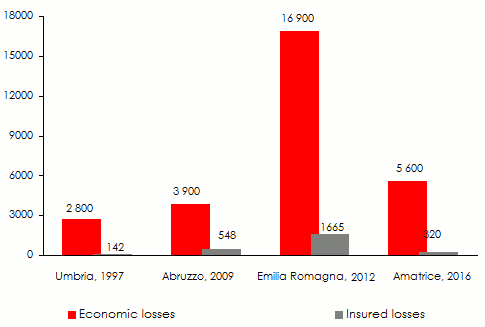Earthquake, The earth has once again been shaken in Italy
With reverberations reaching capital city Rome, the earthquake claimed the lives of 297 people(1) , 230 of whom for the city of Amatrice alone while 387 people were injured. More than 3000 inhabitants found themselves homeless, 2500 of whom are now still living under tents.
2016 Italy earthquake, Financial losses
 Amatrice town on 24 August 2016 © Leggi il Firenzepost, CC BY 3.0 Amatrice town on 24 August 2016 © Leggi il Firenzepost, CC BY 3.0 |
Underestimated at the beginning of the disaster, the material damage related to The August earthquake in Italy turned out to be substantial.
Several cities and villages were devastated. Amatrice, Arquata del Tronto, Pescara del Tronto, Accumoli as well as other counties reported the collapse of tens of buildings, dwellings, public infrastructure, hospitals and schools.
Several historical monuments dating back to the 13th and 14th centuries such as palaces, basilica, and churches also sustained damage. Authorities estimated that 293 of these historical buildings were damaged or destroyed.
According to Lorenzo Codogno, Italian expert and economist, economic losses are likely to attain 5.6 billion USD. As for the department of civil defense, it came up with the figure of 11 billion USD.
Amatrice earthquake, Insignificant impact for insurancein Italy
In spite of the great exposure to earthquakes, the coverage rate of this kind of risk remains quite poor in Italy. Earthquake insurance is still optional and plays out as an extension to homeowners' schemes.
According to the Italian insurance association, nearly 44% of Italians have a homeowners' insurance policy and only 3 to 4% of the contracts include coverage against earthquakes. Ultimately, the association estimates that at least 1% of households is currently protected in the event of an earthquake.
With a very low penetration rate, a poor population density and industrial inactivity in this mountainous region, the impact of earthquakes on insurance companies will be limited.
According to Standard & Poor’s, insurance losses should not exceed 200 million EUR (224 million USD).
Moody’s has, on its part, reported an amount of 283 million EUR (320 million USD), far behind the 2009 and 2012 earthquakes which reported insured damage of 383 million EUR (549 million USD) and 1 260 million EUR (1 665 million USD) respectively. As to A.M. Best, the agency estimates that insurers’ contributions are likely to be limited to 10% of the amounts of economic losses.
In the absence of a compensation device for natural catastrophes governed by law, it is the State that will definitely be in charge of damages and reconstruction costs.
For the record, the total amount of economic losses triggered by the most important earthquakes that took place in Italy during the period between 1976 and 2012 is estimated at 74.8 billion USD. Insurance companies accounted for just 3.3% of this amount, that is, 2.5 billion USD.
(1)Toll established on 16 Septembre by the Italian civil protection
Earthquakes in Italy: economic and insured losses recorded during the 1997-2016 period*
 * the chart lists only economic and insured losses recorded during major earthquakes occuring in Italy
* the chart lists only economic and insured losses recorded during major earthquakes occuring in Italy
2016 Italy earthquake, Poor impact on reinsurance
Reinsurance is hardly affected in the first place by the recent claim, with the majority of the risks being retained by a panel of reinsurers.
Italy earthquake as a recurrent event
The center of Italy, mainly the mountainous chain of Apennis, has frequently been shaken by large-magnitude earthquakes. During the last decade, this region has sustained two major events. On April 9, 2009, the Aquila earthquake claimed the lives of 300 people and damaged more than 10 000 buildings. Three years later, the region of Emilia-Romagna was devastated by two earthquakes, with thirty people being killed and nearly 17 billion USD in damages.
Seismologists and geologists say that this high exposure is accounted for by the position of the Italian peninsular at the junction point of several tectonic plates. The permanent collision between the African plate and the Eurasian one consequently triggers strong seismic activity, especially along geological faults.
Despite the frequency of such events and the high exposure to earthquake risks, many Italian people are still living in the sensitive areas where most buildings do not comply with seismic standards.
According to the Italian national institute of geophysics and volcanology, only 30% of the buildings are currently compliant with seismic standards in Italy. This figure is quite inadequate for a country that is hit every 5 to 10 years by a major earthquake and that has sustained at least seven devastating events in the course of the forty recent years.
Since 1900, the Italian peninsular has been affected by 32 high-magnitude earthquakes.
The most important earthquakes that occurred in Italy from 1970 to 2016
In millions USD
| Date | Location | Magnitude | Economic losses | Insured losses | Number of deaths |
|---|---|---|---|---|---|
| 2016 | Amatrice & its neighbouring towns | 6.2 | 5 600 | 320 | 297 |
| 2012 | Emilia -Romagna | 6 et 5.8 | 16 900 | 1665 | 27 |
| 2009 | Aquila, Abruzzo | 6.3 | 3 900 | 548 | 308 |
| 2002 | Molise | 5.9 | 1 064 | 6 | 30 |
| 1997 | Umbria | 6.1 | 2 800 | 142 | 12 |
| 1980 | Irpinia | 6.9 | 31 900 | 108 | 2 916 |
| 1976 | Friuli | 6.5 and 6 | 18235 | 4,4 | 989 |
Sources: Swiss Re, Moody’s & Wikipedia
Read also:
